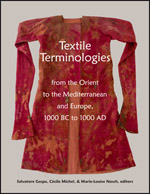Center, Textile Research

Textile Terminologies from the Orient to the Mediterranean and Europe, 1000 BC to 1000 AD
Date of this Version
2017
Document Type
Article
Citation
In Textile Terminologies from the Orient to the Mediterranean and Europe, 1000 BC to 1000 AD, ed. Salvatore Gaspa, Cécile Michel, & Marie-Louise Nosch (Lincoln, NE: Zea Books, 2017), pp. 374-382.
doi:10.13014/K2NV9GD5
Abstract
The Arabic Leinwand (A.L.) collection is held by the Department of Papyrus (Papyrussammlung) in the Austrian National Library of Vienna.1 The collection was acquired in Egypt in the late 19th century by an antiquity trader in Cairo commissioned by Joseph von Karabacek, the famous papyrologist, and contains 68 items.2 Almost all of these have an association with writing, hence the reason why they were collected for the Library, and only eight objects have no association at all. The language for the most part is Arabic with a few texts in Greek, or with Greek with Arabic. The collection of pieces related to writing can be broadly divided into the following two categories:
1. Writing on textiles There are 38 examples of writing on textiles. These are items with epigraphy, with texts written by hand, stamped on, embroidered or woven into the textile. The texts themselves are non-literary and include legal deeds, accounts, letters, talismans, and some may be purses used by merchants to carry money. Embroidered or woven examples, known as ṭirāz, are by far the least numerous, with only three examples in the collection.
2. Writing on paper There are 22 items that make use of reused paper documents. These are fragments of paper that are employed as structural inserts in clothing items including hats. They thus provide information on the work of tailors and hatters in the medieval period.
The papyrologist Adolph Grohmann attempted to organise the collection during the 1920s and 30s and undertook some cataloguing including translating some of the texts. However, only a few of the items, mainly the talismans, were published separately via illustration or a summary of their text. So in other words, this collection is unique and largely understudied. The authors, along with a colleague, are currently completing a catalogue raisonné of this collection, using a multidisciplinary approach to understand as much as possible about the provenance of the items, the date of their production, their use, disposal and entry into the collections. This article presents one example from this collection, A.L. 18, that challenges our understanding of the terminology around textiles identified as ṭirāz, in particularly their use as historical documents, and their status within the communities where they were made and used.
Included in
Ancient History, Greek and Roman through Late Antiquity Commons, Art and Materials Conservation Commons, Classical Archaeology and Art History Commons, Classical Literature and Philology Commons, Fiber, Textile, and Weaving Arts Commons, Indo-European Linguistics and Philology Commons, Jewish Studies Commons, Museum Studies Commons, Near Eastern Languages and Societies Commons, Other History of Art, Architecture, and Archaeology Commons


Comments
Copyright © 2017 Salvatore Gaspa, Cécile Michel, & Marie-Louise Nosch. Photographs copyright as noted.